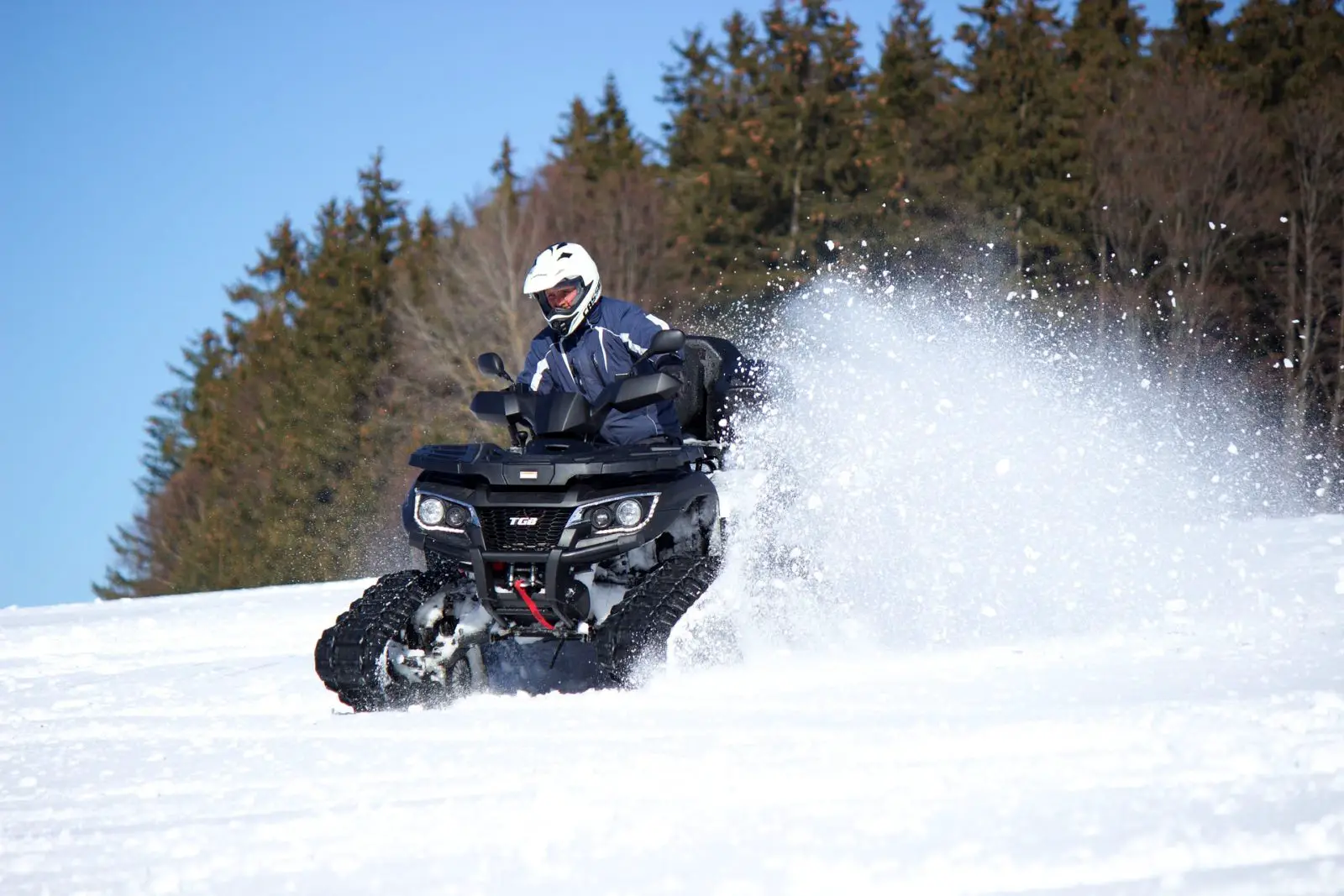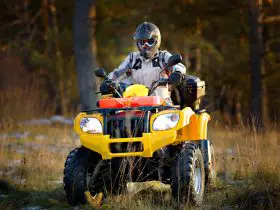If you take your ATV to St. Joe State Park in Missouri, you have the opportunity to play in a wide variety of terrains — dirt, mud, gravel, rocks, sand, and water. Most of the best places to ride give you a diversity of playgrounds, and maybe you worry your ATV might not be able to handle them all. While you might think of an ATV with tracks as only appropriate for snow, they can prove a good solution for handling many challenging locations and weathers.
Adding tracks allows you to use your ATV year-round, giving you extreme performance and traction in less-than-ideal conditions.
However, buying a set of tracks can be tricky given the number of design options and the need to get a set that works well with your specific vehicle and ATV riding style. Let’s take a look at the value of ATV tracks and how to choose a set for your ATV.
Table of Contents
Understanding ATV Tracks
ATV tracks replace tires and wheels with a rubber track fitted to a frame assembly. The main sprocket drives each belt, which then connects to the wheel hub.
Wider tracks provide better traction and a bigger footprint, which reduces the pressure on the ground and allows your ATV to float over the surface better. This is especially valuable on softer surfaces like snow and mud.
Modern kits are lightweight yet durable and available at various price points and come in different types. In general, the more you spend, the more speed, power, and traction you will get from your kit.
The original track designs took inspiration from snowmobile tracks, which makes sense since the main goal of adding tracks to an ATV is to make it useful during the winter snows. The two main parts you’ll install are the rubber tracks and the track frame.
Rubber tracks with a wide, aggressive tread give you optimal grip in all conditions, not just snow. The design needs to still give you enough movement to steer, especially at slow speeds.
While the wider the better, match the size of the track to the power output of your model. Too big and the degree of traction impacts speed further and puts too much strain on the ATV motor. No matter the size, you’ll need an ATV with a strong engine to handle the extra weight of the tracks and pull you through the kind of terrain where tracks work well.
The track frame holds everything together, so it needs to be strong enough to take a beating. However, it still needs an open design so it can shed the mud and snow that can build up as you go over ATV trails. The frame should also articulate to aid in traveling over uneven surfaces.
How Do ATVs with Tracks Perform?
Just how well do tracks perform? They’re going to outperform tires in just about any technical ATV riding situation; think rocks, mud, or snow. Tires sink in and create trenches, which makes it harder to get your vehicle through, but tires give you more speed on flat, smooth surfaces.
The higher ground clearance makes traveling over rocky ground easier, and the wider base improves safety by making it harder to tip the vehicle. Stability will be better, a welcome bonus on steep inclines where most ATV accidents happen.
Snow is the surface where the difference between tires and tracks stands out the most. Tracks allow you to float on top of the snow rather than sink in, and you can get twice the pulling force of tires over hard snow.
Tracks work well in soft, muddy ground for heavy utility work. Much like with snow, you get better flotation and traction to reduce the risk of getting stuck. The great traction, low ground pressure, and more aggressive tread pattern also make them a winner over rocky ground.
Smoother surfaces like asphalt or hard dirt trails are less ideal for tracks, however. You get half the speed you would with tires, and the hard surfaces can create premature wear. If these make up most of your riding time, tracks might not be the best option for you.
Tracks do have one big downside, which is fuel consumption. The increased surface area of the track means more friction than a tire, which is great for traction but bad for gas mileage. In addition, the heavier weight reduces your mpg performance.
Pros and Cons of ATV Tracks
ATV tracks can be ideal for some riders, but not the way to go for others. Here are several things to keep in mind if you’re considering making the switch from tires to tracks.
Tracks cut your top speed by as much as half, making them a less desirable option for nice clear trails. Their great traction allows you to go slow with full control when the terrain gets tricky, however.
Tracks add as much as 110 pounds to your vehicle, which means spending more on fuel. Add that to the far more expensive cost of installing and replacing tracks, and they are an expensive choice just for fun.
Because there’s no air in a track, you lose the cushioning effect tires give you. Tracks rely solely on the suspension in your vehicle for any comfort in the ride. However, tracks can float right over small holes and bridge gaps that might create a bumpy ride with tires.
The wider base of an ATV with tracks adds stability and thus safety, but it can also make it more difficult to get through narrow passes and trails. The vehicle becomes more difficult to steer at slow speeds as well, so power steering is a must.
You need an installation kit specific to your make and model to add tracks to your ATV, along with special parts, brackets, and adaptors to keep the tracks securely in place. While you can do it yourself, the complexity of this job means it might be a better idea to have the initial install done by an authorized dealer or mechanic.
Considering Adding Tracks to Your ATV?
Whether you’re looking for fun in the snow or better function in the mud, ATVs with tracks provide the traction you need, although with compromises to speed. If most of your time is spent off the well-beaten path, tracks can make the experience less frustrating as long as you’re willing to shell out the money for the initial installation.
Learn more about ATV accessories and how to get the best deals when you start looking for an ATV for sale from an ATV trader or dealer in other articles in our ATV section.










